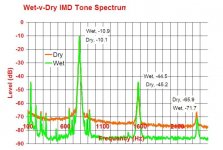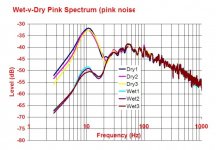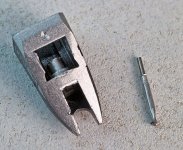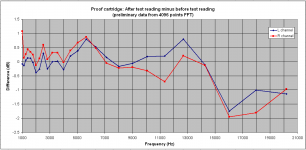Most excellent! Looking forward to seeing what data can be wrung from the file(s) and what analysis LD can do for us.Yesterday I run the “150 plays” test, the way Michael suggested (but with the cartridges swapped. Shure as the proof cartridge, Stanton as the 150 playback cartridge)
I suppose it's all in one big file that needs to be broken up?
For sure! I'm willing, however my OM40 stylus is near the end of its life - I've had it a long time, used it a lot and loved it, so be advised...........it's currently retired but still OK.Although I think it would be very useful to get some data on the sapphire mod to see if LD is right and I will be getting a quote. I have found a good price for the Stylus 40 which seems to make that almost a no brainer. BUT not sure I can stretch to two of them to keep a baseline so LD (who I believe still uses a 40) would need to be willing to do the side to side comparisons if I send the mutant to him. What do people reckon? certainly as LD AND Richard are in agreement on lower compliance being of interest something needs to be done.
I'd love to know about OM40 stylus/cantilever performance on S-120 suspension. There might be an issue with tube diameter, thinking about it, because S-120 is a fine example of fat tube, and OM40 is skinny.
I don't get what sapphire brings to the party as a cantilever......other than commercial sapphire rod exists in about the right diameter......and so does diamond......... the tradeoff as a solid rod doesn't look good IMO.......
LD
One of those Eureka moments...... just realised there is a very interesting elephant in the room as to a possible cause for the effects seen in George's 2.5g 300Hz tests........
Improvement in cart-arm stability, reduction in noise, significant reduction in 3rd harmonic distortion concurrent with near unaltered 2nd harmonic distortion, and modest improvement in test tone level are also all observed in wet playback IME. And correlate with stylus-groove friction coefficient, IME.
So a single cause hypothesis for all effects seen in George's 2.5g 300Hz test suite would be reduced stylus-groove friction with progressive plays.
Attached are some old plots of wet-v-dry playback. The X axis is mislabelled, but shows a fundamental, 2nd and 3rd harmonics.
I acknowledge that Hans has been unable to reproduce these results, but stand by the general observation that friction coefficient correlates with these effects, and wet playback reduces friction coefficient.
I like this explanation: it's simple, plausible and fits. Proposition is the groove gets progressively polished, effectively without changing shape. I still can't explain the effect on 3rd harmonic distortion, but know it to correlate with reduced friction coefficient.
Plausible?
LD
Improvement in cart-arm stability, reduction in noise, significant reduction in 3rd harmonic distortion concurrent with near unaltered 2nd harmonic distortion, and modest improvement in test tone level are also all observed in wet playback IME. And correlate with stylus-groove friction coefficient, IME.
So a single cause hypothesis for all effects seen in George's 2.5g 300Hz test suite would be reduced stylus-groove friction with progressive plays.
Attached are some old plots of wet-v-dry playback. The X axis is mislabelled, but shows a fundamental, 2nd and 3rd harmonics.
I acknowledge that Hans has been unable to reproduce these results, but stand by the general observation that friction coefficient correlates with these effects, and wet playback reduces friction coefficient.
I like this explanation: it's simple, plausible and fits. Proposition is the groove gets progressively polished, effectively without changing shape. I still can't explain the effect on 3rd harmonic distortion, but know it to correlate with reduced friction coefficient.
Plausible?
LD
Attachments
Last edited:
Well first test would be a comparison between new and old to see if there is a significant difference (at least below 20kHz). So no waste in me buying stylus 40.For sure! I'm willing, however my OM40 stylus is near the end of its life - I've had it a long time, used it a lot and loved it, so be advised...........it's currently retired but still OK.
its the blob on the back that matters and I think they are standard since some time back (still have an original 70s concorde to dissect). But this is the thing I need to investigate first, hopefully without lunching £200 worth of stylus.I'd love to know about OM40 stylus/cantilever performance on S-120 suspension. There might be an issue with tube diameter, thinking about it, because S-120 is a fine example of fat tube, and OM40 is skinny.
I don't get what sapphire brings to the party as a cantilever......other than commercial sapphire rod exists in about the right diameter......and so does diamond......... the tradeoff as a solid rod doesn't look good IMO.......
LD
It doesn't but a lot of people report great things and as Boron wire is become harder to get more cartridges are offering it. Would be nice to find out if there is anything in it or just following the herd to the marketing message. Sapphire on M97 seems to be the current vogue amongst the serial cartridge buyers.
As an aside, you can get the same bonded 18um/0.7mil spherical in 3 different compliances from ortofon (25/11/7) but 25cu one is a different cantiliver so it's another multivariable change.
Attachments
Seems plausible, but how to verify? Let's see what George's 150 play run reveals.Proposition is the groove gets progressively polished, effectively without changing shape.
I was wondering the same. Probably need to sacrifice a 50kHz sweep record and see if it's a polish or a wear and how far down in frequency it goes.
I was wondering the same. Probably need to sacrifice a 50kHz sweep record and see if it's a polish or a wear and how far down in frequency it goes.
I've only seen ones that start at 500Hz.
I don't get what sapphire brings to the party as a cantilever......other than commercial sapphire rod exists in about the right diameter......and so does diamond......... the tradeoff as a solid rod doesn't look good IMO.......
B&O used to make a cartridge with a sapphire tube cantilever.
I've only seen ones that start at 500Hz.
I'm assuming and wear from the polishing is above 15kHz.
There will be one-two days more before I will have the 150 test recordings ready for uploading (24b/96k, 33.3sec, 3.2M samples each)
I decided to use the 1kHz to 20kHz stepped freq sweep from the Ultimate Test LP (side 1 Track 6) which allows measurements at 27 specific frequencies.
Preliminary rough data analysis based on 4096 sample FFT from the Shure reading the test track just before the x150 Stanton playback and just after the x150 Stanton playback.
The chart shows the difference.
There is an interlay between some test tones and the harmonics from lower tones, that’s why we see these two bumps.
A 2M sample FFT clears up the scene but it is to be used later.
Now I only want to show that there is no dramatic evidence of vinyl polishing.
George
I decided to use the 1kHz to 20kHz stepped freq sweep from the Ultimate Test LP (side 1 Track 6) which allows measurements at 27 specific frequencies.
Preliminary rough data analysis based on 4096 sample FFT from the Shure reading the test track just before the x150 Stanton playback and just after the x150 Stanton playback.
The chart shows the difference.
There is an interlay between some test tones and the harmonics from lower tones, that’s why we see these two bumps.
A 2M sample FFT clears up the scene but it is to be used later.
Now I only want to show that there is no dramatic evidence of vinyl polishing.
George
Attachments
Hmmm.......such things aren't strictly a matter of frequency: rather a matter of instantaneous programme level, especially if sustained, or a matter of slew rate. All that matters is a groove shape which incurs high stylus-groove force, and presumably wear/polish. So even George's 300Hz@+12dB 2.5g test, apart from having a notable standing VTF stylus-groove force, has significant modulation induced stylus-groove force.I'm assuming and wear from the polishing is above 15kHz.
I tried to explain this, but not sure very clearly.........
LD
I understand that, but if the polishing is also removing useful information, rather than just reducing surface roughness that should remove HF content first. By the time there is a significant glitch in a 300Hz tone in music I would suspect a lot of HF has been ground off.
But I do need to think what a real musical signal with high stylus-groove force looks like. I do forget to think time domain.
But I do need to think what a real musical signal with high stylus-groove force looks like. I do forget to think time domain.
Thank you for doing these tests George, and I so much look forward to the test files.Now I only want to show that there is no dramatic evidence of vinyl polishing.
If the principle effect of polishing is to reduce friction, I wouldn't expect effects to show in f response to any extent. The best marker IME is the cart-arm resonant system which gets stimulated by variations in friction. Other markers are the noise floor, and odd order harmonic distortion. These markers together would be a strong indicator IMO.
LD
Yes, thinking time domain and physical groove is key !I understand that, but if the polishing is also removing useful information, rather than just reducing surface roughness that should remove HF content first. By the time there is a significant glitch in a 300Hz tone in music I would suspect a lot of HF has been ground off.
But I do need to think what a real musical signal with high stylus-groove force looks like. I do forget to think time domain.
For reasons unknown (to me at least), all one has to do to improve 3rd harmonic distortion for a sine tone is reduce stylus-groove friction IME. So no 'ground off' required, and besides it would be a remarkable coincidence if any grinding was in exactly the right place on the groove to produce a purer sine tone, and we can have a very good guess at where the exact location(s) are..........and in the case of wet playback, it's reversible........!
LD
Yes, thinking time domain and physical groove is key !
LD
Different thirds for essentially the same groove geometry raises some interesting questions. I'm used to thirds due to slight symmetrical compressive distortion, is there any way to confirm one way or the other the differences. I'm sure I've seen a geometrical analysis of a given stylus geometry tracing a perfect sine wave track at a constant velocity. Is it even possible that there is a velocity modulation effect due to the change in friction?
I have John Walton's book cited by kgrlee in post #1125, but unfortunately am unable to post the SEM groove photos therein due to limitations in my medieval computer. One of the SEM photos shows groove wall polishing of the stylus contact path (modulated groove, 0.6-mil spherical tip, 3-gm VTF) after 250 plays. Little change in the modulation is evident. This was with a low ETM pickup.
Walton seems to attributes playback harmonic distortion to two separate geometrical effects. (1) Geometrical variance of stylus path when it doesn't follow the groove curvature because of the tip's finite size (tracing distortion). Worse at higher frequencies and modulation levels. This distortion remains even if the vinyl was infinitely hard. (2) "Tip mass distortion" due to vinyl indentation, resulting that the tip is not continuously following the groove surface. Walton shows these two distortions can sometime cancel each other.
Walton seems to attributes playback harmonic distortion to two separate geometrical effects. (1) Geometrical variance of stylus path when it doesn't follow the groove curvature because of the tip's finite size (tracing distortion). Worse at higher frequencies and modulation levels. This distortion remains even if the vinyl was infinitely hard. (2) "Tip mass distortion" due to vinyl indentation, resulting that the tip is not continuously following the groove surface. Walton shows these two distortions can sometime cancel each other.
Thanks for this Charlie.I have John Walton's book cited by kgrlee in post #1125, but unfortunately am unable to post the SEM groove photos therein due to limitations in my medieval computer. One of the SEM photos shows groove wall polishing of the stylus contact path (modulated groove, 0.6-mil spherical tip, 3-gm VTF) after 250 plays. Little change in the modulation is evident. This was with a low ETM pickup.
Would you be prepared to lend it to someone who could carefully scan the whole book? (It's only a short book)
Anyone have experience of doing this and turning the whole thing into a PDF?
There's important experimental stuff there that appears no where else. Some bits did appear in Wireless World & other comics.
Thanks, Charlie.Walton seems to attributes playback harmonic distortion to two separate geometrical effects. (1) Geometrical variance of stylus path when it doesn't follow the groove curvature because of the tip's finite size (tracing distortion). Worse at higher frequencies and modulation levels. This distortion remains even if the vinyl was infinitely hard. (2) "Tip mass distortion" due to vinyl indentation, resulting that the tip is not continuously following the groove surface. Walton shows these two distortions can sometime cancel each other.
Tracing distortion is a geometric certainty. However, it's not just about curvature of groove shapes, it's pronounced wherever there is an angle to the groove line too: pinch effect is at it's worst at the zero crossing point of a high angle groove, for example, representing high level independent of frequency. It's also pronounced at high displacements from the nominal groove line, due to tracking offset angle.
So, in George's test at 300Hz +12dB, curvature apparently isn't the issue: perhaps it is as small as 400um representing only about 30G. But the groove angle at about 25deg peak, representing programme level, is significant, as is peak displacement at about 80um IIRC.
Most, if not all, historic literature seems to focus on curvature/acceleration as the source of stylus-groove force at issue. And be silent about angle and displacement induced sources, which have their origin in cartridge suspension damping and spring, even though they are just as big and relevant to performance and flex.
In the case at hand, ETM is irrelevant, for example, because curvature/acceleration is so small. But the other sources of stylus-groove force are significant, near the limit of trackability. And these seem just as likely to bend or flex whatever will bend or flex.
The locations are different on grooveshape where displacement (suspension spring), angle (suspension damping), and acceleration (stylus inertia) sourced forces apply.
It goes without say that vinyl flex is difficult to tell apart from cantilever flex, and much historic literature never considered cantilever flex, despite on the face of being an order of magnitude or so more significant.
LD
Yes, explaining that is the enigma.......Different thirds for essentially the same groove geometry raises some interesting questions.
Symmetric compression distortion seems plausible: for a velocity sensitive cartridge that would happen around the zero crossing point of a physical sine groove shape, and would mean either the stylus takes a long path, can only be up one side of the groove wall, or perhaps something flexes under increasing force stress? Or twists?I'm used to thirds due to slight symmetrical compressive distortion, is there any way to confirm one way or the other the differences.
Friction would affect the force stress at that time, and thus perhaps the path taken, I suppose. Only shortening the path taken would reduce compression distortion..........which would have to be longer than the locus of the groove base, the ideal, in the first place.
Stylus isn't free to slow down, but it can take a longer path............same thing ?Is it even possible that there is a velocity modulation effect due to the change in friction?
Interesting.......!
LD
- Home
- Source & Line
- Analogue Source
- mechanical resonance in MMs



